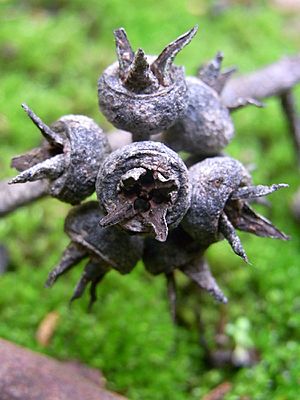Wollemi stringybark facts for kids
Quick facts for kids Wollemi stringybark |
|
|---|---|
 |
|
| Fruit (gumnuts) of the Wollemi stringybark in Yengo National Park, Australia | |
| Scientific classification | |
| Genus: |
Eucalyptus
|
| Species: |
expressa
|
| Synonyms | |
|
Eucalyptus sp. aff. eugenioides (Bees Nest Ridge) |
|
The Wollemi stringybark (scientific name: Eucalyptus expressa) is a special type of tree found only in Australia. It was discovered not too long ago! This tree gets its name from its rough, stringy bark, which peels off in long strips. It also has unique leaves and interesting fruit.
Contents
What Does It Look Like?
The Wollemi stringybark is a tall tree, usually growing between 20 and 45 meters high. That's like a 7 to 15-story building! Its trunk and bigger branches are covered in rough, fibrous bark that looks like strings. This bark is grey-brown, sometimes with reddish parts.
Young Wollemi stringybark plants have leaves that are broad and shaped like a spear or an egg. They are glossy green on top and paler underneath. These leaves are about 50 to 85 millimeters long and 20 to 40 millimeters wide.
As the tree grows, its adult leaves change. They are arranged alternately along the branches and are shiny green on both sides. These leaves are shaped like a spear or are slightly curved. They can be 90 to 160 millimeters long and 18 to 48 millimeters wide. Each leaf has a small stem called a petiole that is 8 to 15 millimeters long. The edges of older leaves can be wavy or have small teeth.
Flowers and Fruit
The flowers of the Wollemi stringybark grow in groups of 7 to 24. These groups appear where the leaves meet the stem (called a leaf axil). Each group of flowers is on a stalk called a peduncle, which is 7 to 15 millimeters long. The individual flower buds are spindle-shaped, about 5 to 7 millimeters long. They have a cone-shaped cap called an operculum on top.
After the flowers, the tree produces woody fruit. These fruits are shaped like a half-sphere or a flattened ball, about 3.5 to 5 millimeters long and 5 to 8 millimeters wide. A unique feature of this tree's fruit is that its "valves" (the parts that open to release seeds) stick out quite a bit, about 3 to 7 millimeters, from the edge of the fruit.
This tree is similar to another species called E. eugenioides. However, the Wollemi stringybark is much taller, has wavy leaf edges, and its fruit has those clearly sticking-out valves.
How It Got Its Name
The Wollemi stringybark was officially described in 2012 by two scientists, Stephen Bell and Dean Nicolle. They found a sample of the tree near Bulga, along the Putty Road. Their description was then published in a science journal called Telopea.
Before it got its official name, people called it E. sp. aff. eugenioides (Bees Nest Ridge). The scientific name expressa comes from a Latin word meaning "prominent and clearly exhibited." This name was chosen because of the fruit's long, narrow, and very noticeable valves that stick out.
Where Does It Grow?
The Wollemi stringybark is a tall forest tree. It grows in at least seven different groups in sheltered valleys within the sandstone mountains north-west of Sydney. You can find it in and around Wollemi National Park and Yengo National Park.
Is It Endangered?
Scientists have suggested that this species has a "ROTAP rarity rating of 2KC." This means it is not very well known and might be at risk of disappearing. It grows in a small area, less than 100 kilometers wide. However, at least some of these trees are protected inside a national park, which helps keep them safe.
Images for kids
-
One of the describing scientists, Dean Nicolle and an associate species of the Wollemi stringybark, mountain blue gum




